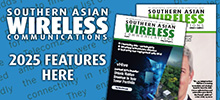07 March 2023
Subodh Vardhan, vice president & managing director South & South East Asia, Motorola Solutions
Throughout history, land mobile radio (LMR) technology has provided the most resilient and reliable form of communication. Major events often cause traditional cellular networks to become damaged or unavailable, but LMR networks provide exceptional coverage, are hardened and are highly secure.
Even if LMR infrastructure is damaged, LMR handsets can operate via Direct Mode of Operation (DMO) for point-to-point communications on the ground without the need for communications infrastructure. This is especially important for enhancing situational awareness and safety among first responders who need to share real-time updates about how events are unfolding with their colleagues.
With so many disasters nowadays requiring a multi-agency response, it’s also important to have equipment such as donor radios programmed and ready to go into the hands of first responders as soon as they arrive on scene.
However, in some emergencies the best and most effective devices for first responders to use are the ones they already carry. That may be a radio handset, but it may also be a smartphone or tablet.
This need has driven the development of broadband push-to-talk services as well as the integration between conventional radio and satellite services to provide continuous coverage in rural and remote areas that may not be serviced by other networks.
Additionally, a growing number of public safety agencies are investing in converged mobile devices that bring together reliable voice communication and access to vital data applications within the one handset.
Critical communications delivery
Southeast Asia is known to be one of the most hazard-prone regions in Asia and the Pacific. It is estimated that the region suffered $91 billion in financial losses from 2004–2014 alone from a variety of events including typhoons, storm surges, floods, drought, and earthquakes.
The unpredictable and frequent nature of disasters in the region make it difficult to plan and prepare for what’s next.
Additionally, the region is naturally exposed to natural disasters with some countries having low lying areas with limited coastal defences and others located on known disaster fault lines.
From a technology standpoint, this further emphasises the need for robust and reliable communication. The availability of spectrum also differs across countries, so technologies that enable instant, interoperable and seamless communication are very important.
The demand for voice communication for effective disaster management isn’t going away. The TETRA and APCO P25 radio standards have long been the most proven global standards for providing resilient and dependable communication for emergency services.
However, the nature of crises and emergency response are both evolving so there is now a far greater need for voice and data both in the field and the control room.
The continuing emergence of advanced, AI-enabled video and software tools are helping to further strengthen the links between responders in the field and their colleagues in the control room.
The ‘visualisation’ of information in the aftermath of a major event such as an earthquake is vitally important. For example, drones and robots can be sent in ahead of human responders to broadcast real-time images, video streams and other situational updates back to the control room. This helps to increase awareness of what dangers may lie ahead before placing responders at risk.
Other new and emerging technologies include intelligent video analytics solutions, AI, citizen engagement tools and software that can also be used to filter, analyse and present actionable data from the masses of information generated during an emergency. Giving responders the most relevant and precise information they need during a crisis helps them to make better and faster decisions and ultimately leads to a safer and more efficient response.
Planning ahead
A well-known term associated with disaster response is the ‘Golden Hour’ - in other words, the brief but critical window of time after disaster strikes where the actions of responders can make all the difference in saving lives and property.
Success during the Golden Hour during a major crisis requires a continuous cycle of strategic and operational planning to establish the right priorities, planning, equipment, and training needs.
Technology plays an important role throughout their entire lifespan of a major event - from the onset of disaster, throughout the recovery stages and lasting until response operations have officially ended.
The future of emergency management will be defined by technology that enables agencies to seamlessly communicate with each other while integrating new data sources to create an even clearer, common picture as disasters unfold.






